Disclosure: Some posts contain affiliate links, which earn us a commission if you make a purchase through them. Positive Fishing © participates in various affiliate networks including the Amazon Services LLC Associates Program.
Depending on who you talk with, mentioning carp can cause several emotions and multiple viewpoints. Carp are well-known for the issues they can cause in waters all over the United States.
However, they are a blast to target with a fishing rod. I got my start in fishing by targeting carp. I went after carp at local dams and reservoirs near my house. Their size and power were enough to keep me coming back to fish for them as much as possible.
While we often hear that they’re overrunning local waters, but that doesn’t mean they’re easy to catch. It takes quite a bit of skill to land these fish. With persistence and a few tried and true techniques, you’ll find yourself in a great position to land them.
In this article, let us learn more about fishing for carp in the United States.
Key Takeaways
- What are the types of carp that can be found in the US?
- What are the best tactics to use, and what baits are best to catch them
- Where to fish for carp in the US?
Types Of Carp Found In The USA
In the United States, there are four types of Asian Carp (black, bighead, grass, and silver carp) and three non-Asian carp (common, mirror, and Koi carp) that already inhabit many of the waters throughout the country.
Carp are not a native species to North American waters. Carp species have been introduced in the USA since the mid-1800s, and to many ecologists, biologists, and anglers, are a major impact on native fish species. Although carp eradication measures have been active for over 100 years, the four Asian carp types in particular – bighead, black, grass, and silver are a concern.
The biggest fear is the carp’s damage to the many Great Lake areas. You can read more about this concern by following this link to a scientific American article on the impact of Asian carp.
Other than the Asian carp, the common carp are the primary species you will find in bodies of water throughout the country. The common carp is part of the Euroasian variety and has several subspecies.
Black Carp
Black Carp can be found all over Eastern Asia and live up to 15 years. These fish have no natural predators, and with a poor digestive system, they eat quite a bit of food.
When black carp are caught, they’re easily identified by their dark body color and grey colors on their belly. Also, you’ll see that their fins are dark as well.
Bighead Carp
Bighead carp are another type of carp you’ll find in the United States. Their lifespan is around 16 years, and they can grow over 40 pounds.
The Bighead is found more in the Mississippi River system rather than in the Great Lakes. These fish can eat over 20 percent of their body weight daily! Identifying them is easy as they have a dark grey color on top of their body and a cream color on the lower half with random black spots on each side.
Grass Carp
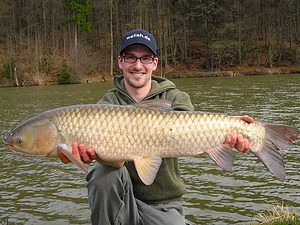
Grass carp are some of the more popular carp you’ll find nationwide. These can be found in the Mississippi River system and the Great Lakes.
The Grass carp will actually eat some of the other carp species. They often eat up to 40 percent of their body weight each day. The 40 percent consists of important plant life within the bodies of water. You’ll find them to have large scales and be dark brown with a white underbelly.
Silver Carp
Silver carp is the carp you see on videos flying through the air around boats. Any boat propeller can cause these fish to jump nine feet out of the water, potentially injuring anglers as they traverse rivers and lakes.
They feed continuously since they don’t have a true stomach. They’re all grey and live in the Mississippi River and many lakes across the Midwest.
Common Carp
Finally, anglers are going to catch the common carp. The common carp is widely respected as one of the hardest-fighting freshwater game fish in the world. It is sought after by specialist carp anglers and fly fishermen.
Commons are found throughout every state in the US, particularly in the Great Lakes system and many surrounding rivers.
Common carp eat fish and plants and are extremely adaptable. Whatever environment they’re in, they easily survive and breed.
Mirror carp
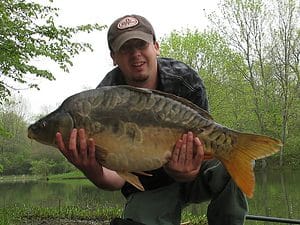
from the common carp
Mirror Carp are a non-native species introduced to Delaware in 1877 by Dr. Spencer F. Baird, who was the head of the United States Commission of Fish and Fisheries at the time. These mirror carp were part of 345 carp, including common carp first brought to the United States.
A mirror carp is, in fact, the same as a common carp; however, due to genetic mutation, the scales are irregular in size and shape. These large scales resemble mirrors – hence the reference to a “mirror.”
Koi carp
Like mirror carp, Koi carp also fall into the same category as common carp. Koi are colorful fish with multiple patterns and color combinations all over their body. They are a domesticated version of the subspecies of the common carp. Unlike the common carp, koi are selectively bred to have vibrant colors and patterns.
Although not spread throughout the country, Koi can be found in many public parks and lakes. The owners likely introduced them into these lakes by releasing unwanted koi into local ponds.
Types Of Carp Not Found In The USA
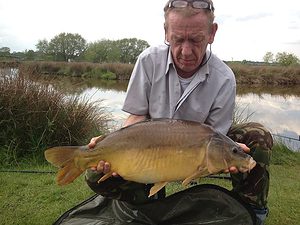
Crucian carp
Despite rumors that crucians were located in a Texas lake in the 1990s, this is not verified, and as such, there are no known populations in any US state currently.
Leather carp
Some anglers may disagree with this statement, but to be fair, there are no leather carp in the USA. In 1877, an unknown quantity of leather carp was imported and placed in ponds in Baltimore; however, whilst other carp thrived, the so-called leather carp did not.
While there are a few photos of leathers being caught in United States waters, it is more than likely that these are confused with mirror carp, either with no scales or very few scales.
Perhaps some over-excited anglers could have been easily confused by the mirror carp they just caught due to its different markings compared to their usual mirror carp.
How to Fish for Carp?
When you fish for carp, you must prepare a few things. They’re a bit finicky, but traditional tactics and most baits continuously work for these fish.
The two main methods for catching carp are:
- Spinning Tackle
- Fly fishing tackle
When using spinning tackle, the setup typically uses three options:
- Legering
- Float fishing
- Free lining (no float or weights)
One great tactic for catching carp on spinning tackle is using a method feeder; it’s a simple rig often used in the UK in any lake or river.
When using flies, the best options are:
- San Juan Worm
- BH Woolly Bugger
- The Headstand carp fly
- Clouser Nymph
You can read more on the best tactics and fly types to use when carp fishing on the fly, with some insider tips on this sometimes unutilized fishing style for catching carp.
What Basic Gear Is Needed To Catch Carp?
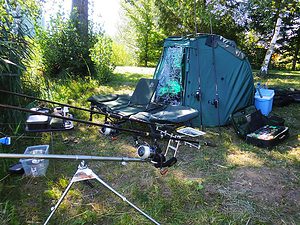
For your tackle, you’ll want a somewhat robust setup. These are strong fish that will test the limits of your gear.
Rod For Carp Fishing
You will want to use a medium 9 to 11-foot length rod for your rod. It’s long enough for you to make those longer casts but powerful enough to fight any double-digit fish you happen to find.
Reel For Carp Fishing
With your medium rod, you can pair it with a size 3000 or 4000 reel. It’ll have the power to help you fight the fish and be able to hold enough line that you’re not going to run out of line if the carp happens to go on an especially long run.
If you plan on catching large carp over 10 lbs, it is best to use a baitrunner of at least a size 6000. My favorite baitrunner reels are from Shimano, which are available in a full range of options up to a size 10000.
Line For Carp Fishing
Carp do not have sharp teeth near their mouths, but due to the carp’s strength, your line should be from 6lbs to 8lbs test for smaller fish weighing up to 10lbs, and 12lbs test for those bigger carp of 15lbs and above.
Carp fight well, and to keep the fish under control and help you avoid any heavy weed or underwater structures, you should only buy a good quality reputable line.
However, carp have extremely good eyesight. Make sure you’re using monofilament coupled with a strong hook length of monofilament or a braided hook length. You’ll likely be fishing in dirtier water, so you have an added advantage due to the lack of visibility.
There are many makes and models of fishing lines available, however, if you are targeting bigger carp, my recommendation is the Fox Exocet or the Gardner GT-HD. Both options are high quality and very popular with specimen carp anglers.
Hooks For Carp Fishing
Size 10 to 12 hooks with a wide gape are the best for catching carp up to and around the 10 lbs mark. For carp in the 15lbs size, you will likely need to use sizes #4 up to #8 to ensure you can land them successfully.
What Bait Does A Carp Eat?

Let us be honest; carp will eat anything! They aren’t very fussy eaters; however, one of the most underrated baits to try is tiger nuts, which will always be a big favorite for specialist carp anglers to use.
Carp are primarily omnivores, eating a wide range of natural food sources. You will need to take a few options when fishing and not rely on one bait; also, what works one day may not work the following trip.
Baits like corn, meat, boilies, pellets, worms, and bread are great options! They’re easy to tie onto the hook, and carp find them extremely attractive.
However, don’t forget to experiment. Baits infused with spices can result in some incredible results, and read my article on fishing for carp with boilies for more detailed information on these tailored baits primarily manufactured specifically for carp.
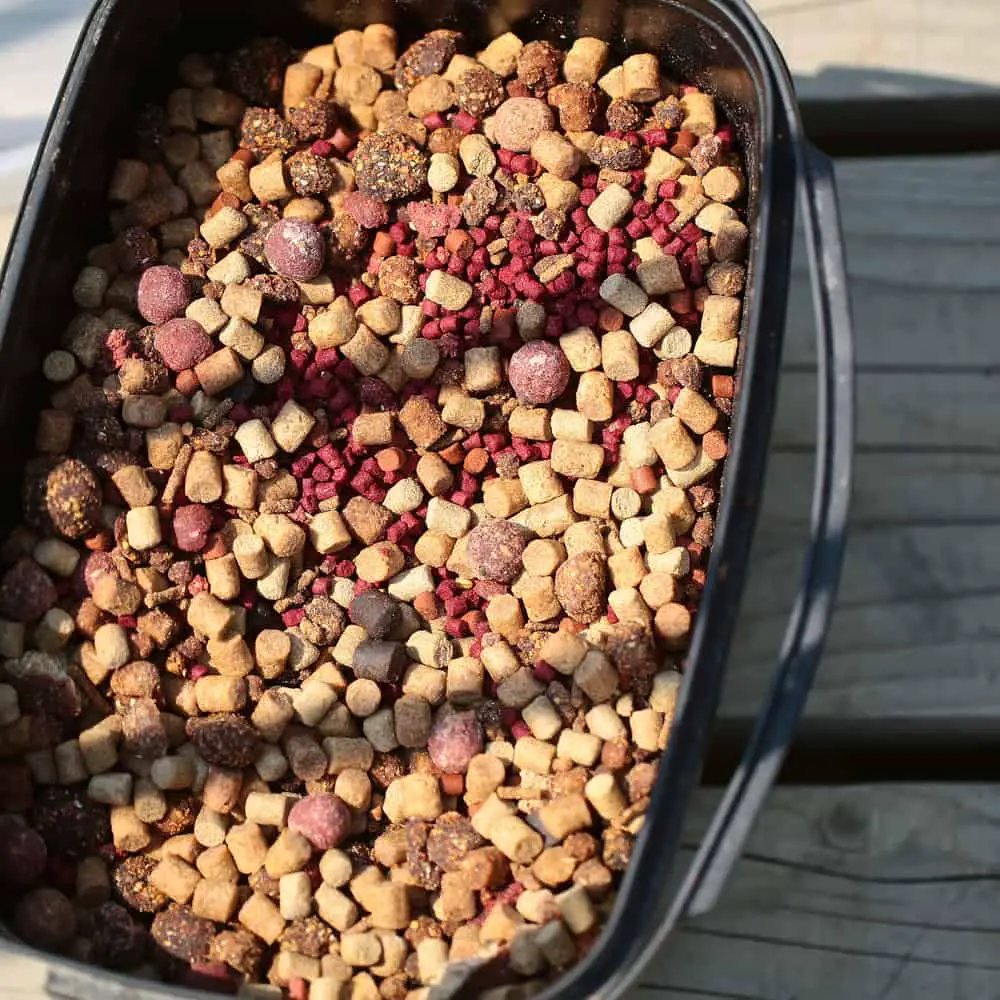
Where To Find And Fish For Carp?
Don’t complicate things when you’re fully rigged and ready to fish. Search for structures under the water.
Carp still like cover and safety. Natural areas such as log piles, rock piles, and heavy vegetation are great spots for carp. Cast near the structure, let your bait fall, and wait for a carp to strike.
Unless carp are feeding off the surface (usually on hot days), ensure you get your bait to the bottom of the water column since carp often feed off the bottom……., especially the bigger carp.
Sight Fishing For Carp
You can often sight fish for carp. They’ll cruise the shallows looking for vegetation or any crustacean. If you cast your bait ahead of the carp in its feeding path, it will find what you’re throwing and try it.
Don’t throw your bait right into the middle of the school of fish. Anticipate their movements, and you’ll have more success. If possible, pick out the larger carp in the group and cast towards them to improve the chances of getting a big carp.
Don’t Be Afraid To Use Chum
Since carp can be somewhat temperamental, it’s smart to chum the water (adding bait to the area you are fishing to attract fish from other locations). Whether you throw bread or corn, it’s a great way to see what the fish are willing to eat. They are known for big appetites, so don’t be afraid to use more bait than usual.
Where to Fish for Carp In The US?
First, comparing fishing in the US and UK is generally quite different. However, the tactics, bait, and locations where they can be found are the same when it comes to carp. You won’t have to search too far as you look for areas to fish for carp. These fish are almost everywhere across every state.
Any check with a local game warden or a Department of Natural Resources website will tell you where the carp population is the highest. Remember, they like heavily vegetated water with a variety of depths.
The Midwest and the southern United States have healthy populations of these fish.
Check with local regulations on what to do when you land a carp. Some states require that they must not be released back into the water! This rule is state-dependent; a quick check with your state regulations will tell you what you need to do.
Where To Find More Information On USA & Canada Carp Fishing?
Carp fishing in the United States is gathering momentum, especially among specialist anglers. Here are a few great resources on carp angling.
Final Thoughts
Carp fishing can be tremendously exciting; their fight and power can make an exciting day of fishing. Whilst carp are not everyone’s favorite fish to catch, they are starting to gain interest in United States fishing circles.
I hope this article was informative and gave you basic knowledge and tips on fishing for carp in the USA. You can read more detailed information about catching carp and the best carp baits to use, which are easily available, affordable, and easy to use!
- 5 Best Fishing Bags For Getting Your Gear Organized - January 13, 2025
- 4 Essential Surf Fishing Rigs - January 11, 2025
- How To Know The Sex Of A Fish You Have Caught? - December 9, 2024

